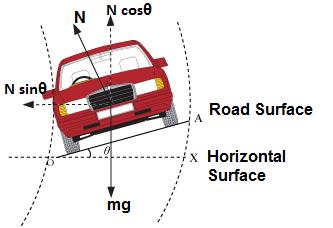Whenever a roadway (or railway) is laid on a curved path, then its outer edge is always made higher than the inner edge, to keep the vehicle in equilibrium while in motion.
The amount by which the outer edge is raised, is known as cant or superelevation. In case of roadways, the process of providing superelevation is known as banking of the road.
The general practice, to define the superelevation in roadways, is to mention the angle of inclination (also called angle of banking) of the road surface.
In case of railways, the general practice to define the superelevation, is to mention the difference of levels between the two rails.
80) The slope on the road surface generally provided on the curves is known as
Angle of banking

Related KPCL AE Mechanical Question Paper - 2018 with Answer Key
All of these
The tool may fail due to
* cracking at the cutting edge due to thermal stresses
* chipping of the cutting edge
* plastic deformation of the cutting edge
Charle's law
Different types of thermodynamic processes are
1.Constant Volume process or Isochoric Process
2. Constant Pressure Process or Isobaric Process
3. Hyperbolic process
4. Constant Temperature process or Isothermal process
5. Adiabatic process or isentropic process
6. Polytropic process
7. Free expansion process
8. Throttling process
Constant volume process or isochoric process:
When the gas is heated at a constant volume, its temperature and pressure will increase. Since there is no change in its volume, no external work is done by the gas. All the heat supplied is stored in the body of the gas in the form of internal energy. It may be noted that this process is governed by Gay Lussac law.
Constant pressure process or isobaric process:
When the gas is heated at a constant pressure, its temperature and volume will increase. Since there is a change in its volume, the heat supplied is utilized in incresing the internal inergy of the gas, and also for doing some external work. It may be noted that this process is governed by Charles law.
Hyperbolic process:
A process, in which the gas is heated or expanded in such a way that the product of its pressure and volume remains constant, is called a hyperbolic process.
This process is governed by Boyle’s law.
Constant temperature process or Isothermal process:
A process, in which the temperature of the working substance remains constant during its expansion or compression, is called a constant temperature process or isothermal process. This will happen when the working substance remains in a perfect thermal contact with the surroundings, so that the heat ‘sucked in’ or ‘squeezed out’ is compensated exactly for the mechanical work done by, or on the gas respectively. It is thus obvious that in an isothermal process there is no change in temperature and no change in internal energy.
Adiabatic process or Isentropic process:
A process, in which the work substance neither receives nor gives out heat to its surroundings, during its expansion or compression is called an adiabatic process. This will happen when the working substance remains thermally insulated, so that no heat enters or leaves it during the process. It is thus obvious, that in an adiabatic process no heat leaves or enters the gas, the temperature of the gas changes, as the work is done at the cost of internal energy and the change in internal energy is equal to the work done.
Polytropic process:
The polytropic process is also known as the general law of the expansion and compression of gases.
Free expansion process:
A free expansion occurs when a fluid is allowed to expand suddenly into a vacuum chamber through an orifice of large dimensions. In this process, no heat is supplied or rejected and no external work is done. Hence the total heat of the fluid remains constant. This type of expansion may also be called as constant total heat expansion.
Throttling Process:
when a perfect gas is expanded through an aperture of minute dimensions, such as a narrow throat or a slightly opened valve, the process is termed as throttling process. During this process, no heat supplied or rejected and also no external work is done. Moreover, there is no change in temperature, and so the total heat of the fluid remains constant.